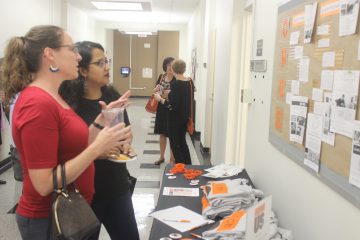By DAVID DUPONT
BG Independent News
Protests in spring, 2017 against the way Bowling Green State University handles sexual assault are bearing fruit.
That was evident Wednesday night during a reception to mark the opening of the Center for Women and Gender Equity in Hayes Hall. The center was formerly called the Women’s Center and located in Hanna Hall.

Faculty member Jolie Sheffer and America Culture Studies graduate student Riddhima Sharma look at a display in the new Center for Women and Gender Equity.
With the retirement last year of its founding director Mary Krueger, the future of the center founded 20 years ago seemed uncertain.
Then a female student came forward and made public her experience first being raped and then the way her report of her assault was handled by the university.
In response, then BGSU president Mary Ellen Mazey created a task force on sexual violence.
The task force met over summer, 2017. Faculty member Maureen Wilson, one of three co-chairs of the group, said Wednesday that the group released a lengthy report with many recommendations.
Mazey accepted all those recommendations. The result was the hiring of a new full-time director, Angela Clark-Taylor, and a new Title IX officer Jennifer McCary, who serves as an assistant vice president for student affairs.
The new center is more than the women’s center with a new name and location.
The new space is adjacent to the Violence Prevention Center that Clark-Taylor co-directs with Faith DeNardo, the director of the Wellness Center.
This is an auspicious pairing, Clark-Taylor said. “Now you can access those services all in one space.”
The new Center for Women and Gender Equity has a small conference room, a lounge, a smaller space that can be used for private counseling or mothers needing a place to breastfeed their babies as well as office space.
Clark-Taylor said that in addition to maintaining the programming aimed at grad students, faculty and the community, the center will expand its programming for undergraduates.
That will include a Friday reading group, and training on philanthropy, political action, and leadership.
The new name, Taylor-Clark said, doesn’t reflect a change in the center’s mission, but a recognition of what it was at the beginning.
“We want to work with everyone around gender identity issues,” she said. That includes everyone who identifies as female or male.
McCary urged faculty attending the reception to consider collaborating with the center to present programs.
Reporting acts of sexual violence is important — just that day faculty received notification that they are mandatory reporters. And renewed energy needs to be put in the It’s on Us and Step Up Step In programs.
“We really need to shift the focus to violence prevention,” she said.
Part of that will be the hiring of a student engagement coordinator. That job is about to be advertised, DeNardo said, and should be filled by January.
“One of the important responsibilities is engaging men on this issue,” she said. That means finding spaces where men are comfortable discussing the issue of sexual violence with other men.
All this is part of the measures called for in the task force report. McCary said that about 80 percent has been accomplished. She praised President Rodney Rogers continued commitment to the initiative.
There’s a cloud over the horizon. The Trump Administration has rescinded the guidance from the Obama Education Department on how campus sexual assault accusations should be handled.
These lessen the scope of what colleges and universities are required to investigate and raise the standard for holding an alleged perpetrator responsible.
The proposed guidelines call for “clear and convincing” evidence as opposed to the current “preponderance of evidence” standard that BGSU and other institutions use, DeNardo said. “We have to see what those final recommendations look like.”

